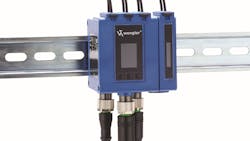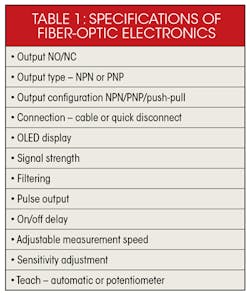This file type includes high-resolution graphics and schematics when applicable.
Sensing part presence in machines, in fixtures, and on conveyors is an important component of industrial automation. Error-proofing assembly and controlling sequence based on presence or absence of a part is often required. In many cases, one can’t just assume the part is where it should be or the nest is empty as expected, so a presence sensor must be used for verification.
Many types of sensors are available, including inductive, magnetic, capacitive, and photoelectric. Each has its own strengths and weaknesses depending on the application. Photoelectric sensors, however, have the broadest offering of types and technologies, and the widest range of applications.
Photoelectric sensors come with a variety of light-emission types (infrared, visible red, laser Class 1 and 2), sensing technologies (diffuse, background suppression, reflective, through-beam), and housing configurations (photo eye or fiber optic). This article focuses on specifying and applying fiber-optic sensors, which offer advanced capabilities and configuration options, and are great for tight spots that are too small for a photo-eye sensor.
Fiber-Optic Technology
Fiber-optic sensors, sometimes called fiber photoelectric sensors, include two devices that are typically specified separately: the amplifier, often called the electronics or fiber photoelectric amplifier; and the fiber-optic cable, which includes the optic sensor head and the fiber cable that transmits light to and from the amplifier.
The basic theory behind all photoelectric sensors is quite simple. Every photo eye has a light emitter producing the source signal and a receiver that looks for the source signal. Many different technologies exist for sensing and measuring the light transmitted to the receiver. For example, background suppression sensors look for the angle at which the light is returned, while standard photo eyes look for the amount of light, called excess gain, returned to the sensor. Other sensors monitor the time light takes to return, thus providing distance measurement.
Photo eyes house the emitter and receiver in either one optical sensor head, such as that used in diffuse and reflective units, or two optical sensor heads like those used in through-beam units. Fiber-optic sensors put all of the electronics in a single housing, with the optical heads for the emitter and receiver separated from and connected to the electronics housing via a fiber cable. The emitted and received light travels through these fiber cables, much like high-speed data in fiber-optic networks.
One benefit to this segregation is that only the sensor head needs to be mounted on the machine. The integrated fiber-optic cable is routed and plugged into the amplifier, which can be mounted in a safe place (typically a control enclosure), protecting it from the often harsh manufacturing environment.
The variety of options available for both amplifiers and fiber-optic cables is vast. Amplifiers range from basic to advanced, and machine builders continue to demand more functions, including logic and communication capabilities.
Fiber-Optic Sensor Amps
Fiber-optic amplifiers range from those with basic electronics and plug-and-play functionality to models with fully configurable electronics (Fig. 1). Some even have electronic units that can handle up to 15 fiber inputs in a manifold-like configuration. Output indication is highly desirable on fiber-optic electronics, as it shows whether the sensor is working properly, but other basic functions (Table 1) must be specified. The output format and connection to the amplifiers are important because they define the interface to the controller, and teaching the on and off setpoints is an integral part of amplifier configuration.
Output types can be set normally open or normally closed—as well as switching via sinking, sourcing, or push-pull. This allows the device to either sink or source the signal automatically, depending on how the circuit is wired. Electrical connection options are generally prewired with at least a two-meter length of cable, or a quick disconnect with a standard M8 or M12 multi-pin connector. Switch settings are programmed by dialing-in a potentiometer or digitally via pushbuttons.
Beyond the basics, advanced amplifier capabilities provide significant flexibility with features such as pulse outputs, on/off delays, and the ability to eliminate intermittent signals. These advanced electronics give machine builders the ability to drill down and adjust amplifier parameters as required by the application.
On/off delays are often desired to slow the reaction of the control system to changes in sensed parameters. In the case of intermittent signals, some applications present the sensor with spurious, short-term signals that aren’t consistent with overall operating conditions. The ability to eliminate these signals at the sensor frees up the controller from this task.
Most all models will provide output-status LEDs, while some offer graduated displays to provide a coarse view of signal strength and output status. More advanced units have multiline OLED displays with customized diagnostics and programming.
Filtering is an option often needed with increased sampling rates, as it provides a more resilient measurement less susceptible to ambient conditions. This stronger signal, however, requires the unit to operate at slower switching frequencies. Pulse outputs allow for stretching of the input signal, which may help when the operating frequency is too fast for a PLC input. On/off delays give machine builders the ability to add timers when the output signal starts and stops.
Advanced units provide more programming options, such as sensitivity adjustments. Using these options, machine builders can teach the machine to sense part absence, part presence, or both—even with difficult materials such as glass. This teaching function reduces or eliminates the need for programming the controller to perform these functions. They can also program the output to switch off/on inside two switch points. By way of example: For part positioning, a switch could turn on at one position and off at another such as in a fill level signal for a pump application.
Seeing the Light with Fiber Cable
Fiber-optic cables don’t conduct electricity; instead they transmit light. They come in a variety of configurations with different material types and optic head styles (Fig. 2). Table 2 lists some of the decisions to be made when specifying fiber-optic cable.
Diffused fiber-optic cables have two leads to insert in the amplifier for the emitter and receiver light, with the two leads joined together near the single optical head. Through-beam fiber-optic cables are two separate, identical cables that are connected to the amplifier, each with their own optical head. One cable transmits the emitting light, and the other transmits the receiving light. A common mistake is only ordering one through-beam cable, as some suppliers may provide one piece per part number, while others package the required two cables.
Fiber materials are generally either plastic or glass. Plastic units are thinner, less expensive, and provide a tighter bending radius, while glass units tend to be more rugged and can handle higher operating temperatures. Plastic fibers can be cut to length with a special one-time cutter; glass fibers aren’t able to be cut once received from the supplier. The fiber jacket material can also vary from a basic extruded plastic, on up to stainless-steel braiding to operate reliably in the toughest environments.
Round bundles in a diffuse head can be strictly bifurcated with all emitter fibers on one half and all receiver fibers on the other. This is common, but can provide a lag in reading a part moving perpendicular to the bifurcation line. Another option is to have the emitter and receiver fibers dispersed evenly in the head to produce a more homogenous beam. Homogenous fiber mixing gives equal exposure to sending and receiving light, and provides detection independent of part travel direction.
Sensing range for fiber optics will be impacted by the amplifier, fiber cable length, and type of optical head. Thus, it is usually difficult to determine an exact working range, but suppliers typically supply an estimate. Generally speaking, through beam has longer range than diffuse. The longer the fiber cable, the shorter the range, and advanced amplifiers usually have stronger emitting signals and longer ranges as well.
Connecting Fiber-Optic Sensors
Use of distributed I/O and distributed smart devices has been increasing throughout machine automation, and fiber-optic sensors are no exception. Connecting multiple fiber-optic sensor cables to a single manifold of electronics has its advantages.
Fiber-optic amplifiers are typically single-channel standalone units. With slim housings and common DIN rail mounting, they can easily be sandwiched and stacked in a panel. One drawback may concern the routing of electrical connections for each single amplifier.
Another option is to use a fiber-optic manifold, which groups multiple fiber channels to one central control and electrical point (Fig. 3). These fiber-optic manifolds typically utilize an OLED display with menus to allow for programming of each fiber channel. Each fiber channel can be configured separately, such as setting light-on or dark-on, and switching hysteresis. This central control also enables grouping of outputs via basic AND/OR logic, which can reduce and simplify the output signal to the PLC.
Applications and Issues
Fiber optics work well, and are commonly used, in applications where significant electrical noise is generated by sources such as automated welding, variable frequency drives, and motors. Fiber cabling is immune to electrical noise, and the electronics can be mounted away from the noise in a shielded enclosure.
Another very common application is small part assembly. These operations tend to be fully automated, and thus require multiple sensors to confirm part placement (seated) and assembly verification to confirm completion of an operation. Typically, the parts are moving in and out of a stage quickly on carriers or an indexing table. Because travel tolerance is minimal, precise measurement of position becomes essential.
A fiber-optic solution provides various options in head size, orientation, and light dispersion to allow the smallest and most accurate light focus for each application, regardless of the electrical housing size. With on-board logic, one channel of a two-channel sensor can confirm a part is in place to trigger an assembly action, while the other channel is able to confirm that assembly was completed.
A common issue in fiber-optic installations concerns excessive flexing of the fibers. Since the fiber cables are bundles of individual fibers, they typically feel quite pliable, allowing an installer to easily bend the fibers beyond their recommended maximum bend radius. This can cause irrecoverable plastic deformation of the fibers, which will reduce the light transmission or, in the worst case, sever it entirely. The maximum bend radius, listed with all fibers, varies depending on fiber material, bundle size, and fiber dispersion in the bundle—and it must be adhered to in all cases.
Regardless of the application, machine builders must select the proper sensor technology. If fiber-optic sensors are used, amplifiers and fiber-optic heads must be carefully selected for the application to provide robust sensing performance.
Andrew Waugh is the product manager for sensor and safety products at AutomationDirect. He has more than 16 years of experience with machine sensor and safety devices used in packaging, assembly, material handling, and process control equipment.








